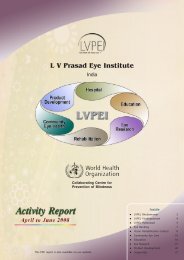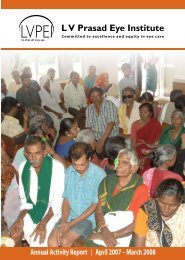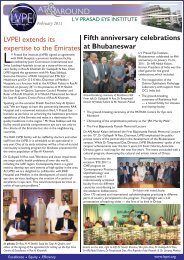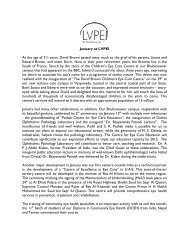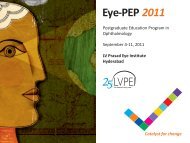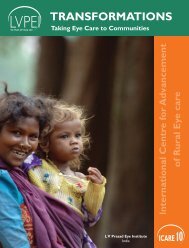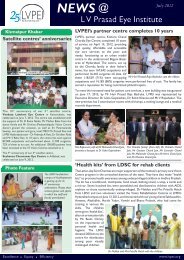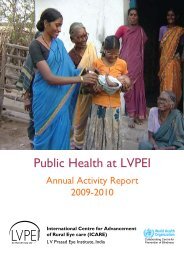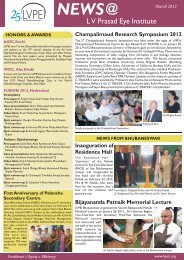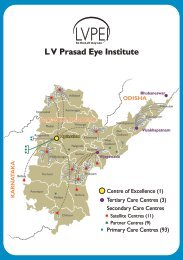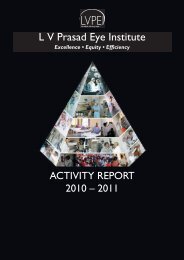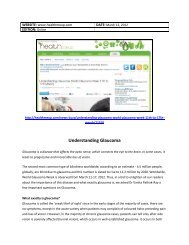IERG Abstracrt Book.indd - LV Prasad Eye Institute
IERG Abstracrt Book.indd - LV Prasad Eye Institute
IERG Abstracrt Book.indd - LV Prasad Eye Institute
Create successful ePaper yourself
Turn your PDF publications into a flip-book with our unique Google optimized e-Paper software.
46 Oral PresentationChloramphenicol susceptibility was very low at 26.5% and 47% against S. aureus and CoNSisolates respectively.Conclusions: This study reveals that prevalence of methicillin resistance was high in CoNScompared to S. aureus isolated from ocular infections. Cefazolin is a good option for thetreatment of methicillin resistant staphylococcal eye infections.Paper Session V, Visual Neurosciences and Optometry, August 1, 2010,8.45 - 10.15 hrsChairs: L Srinivasa Varadharajan and Srikanth BharadwajIPT 026Age-Related Changes in the Optomechanical Properties of Human Lenses: AComparison of Indian and American <strong>Eye</strong>sAshik Mohamed, 1 Mukesh Taneja, 1 Fabrice Manns, 2,3 Pesala Veerendranath, 1 Derek Nankivil, 2 PravinVaddavalli, 1 Arthur Ho, 4,5,6 Virender Sangwan, 1 Robert Augusteyn, 5,6 Jean-Marie Parel 2,3,51L V <strong>Prasad</strong> <strong>Eye</strong> <strong>Institute</strong>, Hyderabad, India; 2 Ophthalmic Biophysics Center, Bascom Palmer <strong>Eye</strong><strong>Institute</strong>, Univ. of Miami Miller School of Medicine, Miami, FL; 3 Dept. of Biomedical Engineering,Univ. of Miami College of Engineering, Coral Gables, FL; 4 Brien Holden Vision <strong>Institute</strong>, Sydney,Australia; 5 Vision Cooperative Research Centre, Sydney, Australia; 6 School of Optometry andVision Science, University of NSW, Sydney, Australia.Purpose: To determine the age-related changes in the optomechanical properties of humancrystalline lenses from Indian and American <strong>Eye</strong>-Banks during simulated accommodation in alens stretcher.Methods: Post-mortem human eyes obtained from the Ramayamma International <strong>Eye</strong> Bank,India (n=57, Age=1day-70yrs, PMT=15-87 hrs) and from several <strong>Eye</strong> Banks in the United States(n=56, Age=6-85 yrs, PMT=24-120 hrs) were dissected according to a protocol describedpreviously (Parel et al, ARVO 2002) to produce specimens that maintained the lens in itsaccommodating framework, including the zonules, ciliary body, anterior vitreous and a scleralrim. The specimens were mounted in a lens stretching system (EVAS-I) which simulatesaccommodation by stretching the outer sclera 2 mm radially in 0.25mm increments. The load,lens equatorial diameter & power were measured at each step. The unstretched lens diameter& power, diameter-load and power-load responses were plotted as a function of age. The agedependenceof the Indian and American eyes were compared.Results: The unstretched lens diameter increased with age logarithmically, in mm at7.19+0.56*ln(Age) and 7.44+0.45*ln(Age) for Indian and American eyes respectively. Theunstretched lens power decreased with age logarithmically, in D at 54.60-8.44*ln(Age) and56.80-8.97*ln(Age) for Indian and American eyes respectively. The change in lens diameter andpower per unit load also decreased with age showing similar trend in both the populations. Noaccommodative response was observed in eyes older than 50 years of age.Conclusions: Over the age range examined, there is no measurable difference between theIndian and American lenses in their optomechanical properties.



